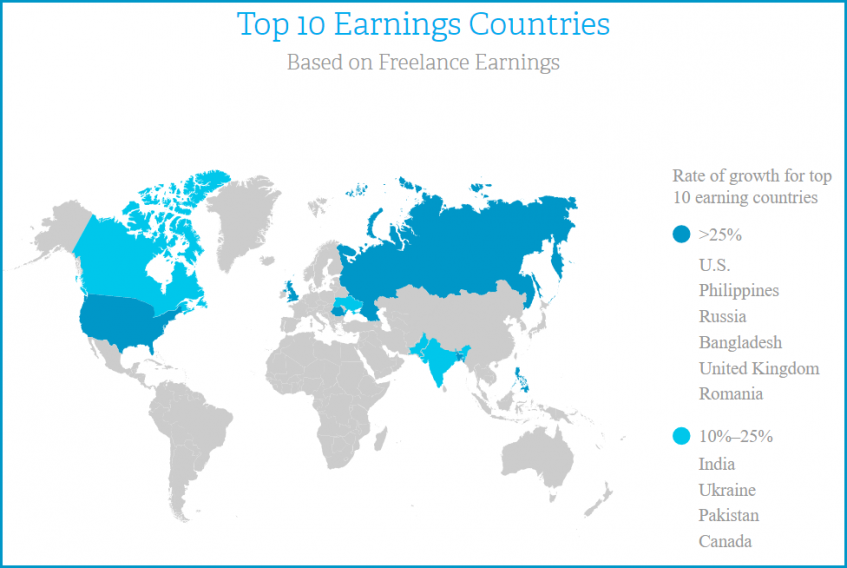
Why Freelancing is Taking the World by Storm
The world of work is changing. The once standard 9-to-5 office job is evolving into something virtually unheard of just a few short decades ago, the freelance gig.
The Evolution of the Freelance Economy
It is true that there have always been those few brave souls who strike out on their own to craft their own career destinies. But freelancers were few and far between in the 1970s, 80s, and 90s. Large corporations at the time were sucking up major talent, drawing the best and brightest of creatives into their corporate structure.
However, the tide began to turn toward freelancing at the dawn of the 21st century. Why? A number of factors have led to a “perfect storm” of sorts that make freelancing increasingly attractive to growing numbers of talented professionals worldwide. Here are some of them:
- The advent of new technologies and the internet, that enable workers to collaborate remotely.
- Uncertain economic conditions which have inspired many talented professionals to seize control of their own career course.
- A trend toward corporate downsizing and the use of contingent workers to reduce employer costs.
- Growing frustrations with the corporate environment and employee dissatisfaction.
- Growing demand for self-scheduling and a more malleable work/life balance.
The combination of these factors has led to a sea change in the way freelancing is perceived globally. Rather than the old stereotype, which portrayed freelancers as workers lacking drive, ambition, or talent, the modern perception embraces freelancers as motivated entrepreneurs with talent, professionalism, and the ability to get the job done with a minimum of fuss and bother.
Global Freelancing by the Numbers
Here’s a brief world tour of freelancing as it stands today:
The United States: Paychex reviewed a recent survey by Freelancers Union and Upwork, which reveals that there are currently approximately 53 million freelancers in the U.S.; this means that 1 out of 3 U.S. workers is a freelancer. The Paychex report reviewed information from over 400,000 resumes posted on freelancer job site Indeed.com. Here is what the study found:
- Between 2000 and 2014, freelance jobs listed on the resumes reviewed increased by 500 percent.
- 14.3 million of America’s freelancers are classified as “moonlighters”, meaning that they work other jobs and take freelancing jobs on the side.
- 21.1 million U.S. freelancers are traditional freelancers, meaning that they work from project to project on their own without formal employment elsewhere.
- Freelancers contribute an estimated $715 billion in earnings to the U.S. economy.
- About 1 in 12 U.S. households rely on independent work for more than half of their income.
The United Kingdom: Freelancers are also gathering steam in the UK. Here are some stats to prove it:
- There are 1.4 million British freelancers working across all sectors, which represents a 14 percent increase over the past decade.
- Freelancing is now seen as a highly attractive and lucrative career option by 87 percent of students with first or second class degrees.
- 29 percent of all graduates say freelancing is part of their career strategy for the next five years, a fact that suggests the freelance economy will continue to gather pace in the UK.
The European Union: There are over 8.9 million freelancers in the EU, and their increasing numbers make them the fastest growing group in the EU labor market. Notably, Italy has a 21 percent self-employment rate, while Spain and Slovakia both have a 13 percent self-employment rate.
India: There are 15 million independent workers in India, making it second only to the U.S. in freelancers. Indian freelancers account for about 40 percent of the world’s freelance jobs.
Other countries with large numbers of freelancers include: The Philippines, Bangladesh, Russia, and Romania.


Upwork’s Global Online Work Report 2014
Top Jobs for Freelancers
One of the most attractive things about freelancing for many is the diversity of career options it affords. This may, in fact, be one of the factors that are currently swelling the ranks of freelancers globally. Here are some of the most popular jobs for freelancers:
- Graphic design
- Content marketing
- Virtual assistance
- Electrical engineering
- Web development
- Programming
- Translation
FastCompany lists the top ten industries for freelancers as:
- Computer and IT
- Administrative
- Accounting and Finance
- Customer Service
- Software Development
- Medical and Health
- Project Management
- Research Analyst
- Writing
- Education and Training
As this list proves, there is growing demand in many industries previously not associated with large numbers of freelancers. As technology makes freelancing more accessible to larger swaths of the working population, the possibilities for freelance work in many additional industries will likely increase.
The Future of Freelancing
EY.com reports that 40 percent of organizations expect to increase their use of contingent workers (AKA freelancers) in the next five years. Significantly, one in three employers of 100,000 employees or more expects to use 30 percent or more contingent workers in the same timeframe.
Tony Steadman, Americas Total Talent Supply Chain Advisory Leader, EY, states: “We are seeing a convergence of cost reduction initiatives and the need for employers to have more agility, with workers looking for more flexibility. Together, these objectives are driving a shift toward a contingent workforce.”
According to SmallBizTrends.com, some researchers project that half of the working U.S. population will move into the gig economy within the next five years, and that half of the United Kingdom’s working population will be self-employed in that same amount of time.
FastCompany says about the future of freelancing: “Talent-matching platforms and co-working spaces are just two leading trends behind a freelancer economy that’s growing more robust by the day. Other models and services are bound to spring up to bridge more gaps between consultants and companies in more flexible ways than ever before…it’s worth remembering the new freelancer economy isn’t about “temp” labor. Independent workers are increasingly strategic, experienced, and professional. They want more flexibility than a traditional employee, and in many cases they’re getting it.”
What will freelancing look like in a decade? It is hard to say. One thing, however, is certain. The availability of technologies that make freelancing possible, the growing need for organizations to cut costs while still leveraging the skills of top talent, and the ever-present worker quest for a good life/work balance will continue to fuel the freelance revolution for some time to come.
Getting Paid for Your Freelancing Efforts
When you take your talents global, you need a global payment processing solution to ensure that you are paid quickly and efficiently. Freelancers around the world enjoy the ease and convenience of Payoneer’s payment processing solution. Why not explore what Payoneer can do for your freelance business today?




